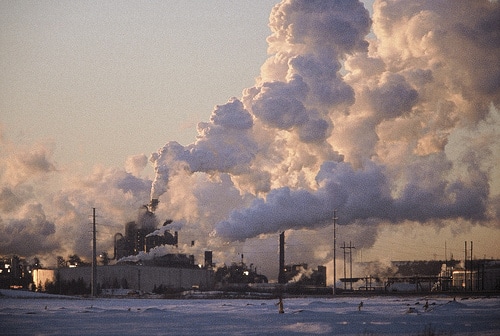Today federal scientists from Environment Canada presented research at an international toxicology conference in the U.S. that indicates contaminants from the Alberta tar sands are polluting the landscape on a scale much larger than previously thought.
A team lead by federal scientist Jane Kirk discovered contaminants in lakes as far as 100 kilometers away from tar sands operations. The federal research confirms and expands upon the hotly contested findings of aquatic scientist David Schindler who, in 2010, found pollution from the tar sands accumulating on the landscape up to 50 kilometers away.
“That means the footprint is four times bigger than we found,” Schindler told Postmedia News.
Senior scientist Derek Muir, who presented some of the findings at Wednesday’s conference, said the contaminated region is “potentially larger than we might have anticipated.” The ‘legacy’ of chemicals in lake sediment gives evidence that tar sands pollution has been traveling long distances for decades. Samples show the build up of polycyclic aromatic hydrocarbons, or PAHs, known to cause cancer in humans and to be toxic to aquatic animals, in 6 remote and undisturbed lakes up to 100 kilometers away from tar sands operations.
The pollutants are “petrogenic” in nature, meaning they are petroleum derived, and have steadily and dramatically increased since the 1970s, showing the contaminant levels “seem to parallel the development of the oilsands industry,” Muir said.
After the release of Schindler’s groundbreaking research on tar sands pollution in 2010 the Alberta government claimed the contaminants were naturally occurring and posed no risk to aquatic life.
However at today’s conference, the annual meeting of the North American Society of Environmental Toxicology and Chemistry, Kirk discussed the long list of ‘priority pollutants‘ that accumulate in the region’s snow. Within 50 kilometers of the tar sands, snowpack contains numerous contaminants including dangerous neurotoxins, such as methyl mercury, that bioaccumulate in food webs. Kirk found priority pollutants in the air were 1.5 to 13 times higher at test sites within 50 kilometers of tar sands refineries, and highest within 10 kilometers.
Abstracts for Kirk, Parrott and Muir’s presentations can be found on pages 103 and 104 of the conference programme (pdf).
“We don’t really know the fate of the various metals including mercury as they go from snow, to melt water to run-off and then into the aquatic environment,” Muir told Postmedia.
The toxicity of melt water from snow falling in the tar sands region was researched by federal scientist Joanne Parrott, who also presented at the conference. Studying snow samples taken in 2011 and 2012 along the Athabasca River, Parrott found that the melt water was toxic to minnow larvae, even when diluted down to 25 percent. “The larval fish don’t do very well in that snow at all,” she said.
Parrott suggests melt water, once mixed with water from the Athabasca River, will no longer be toxic to minnows.
Snow melt, however, provides a significant amount of water to tributaries where fish hatch in the spring, says Schindler. “My big concern is that slowly because of mortalities at spring melt, that this will erode the fishery, killing off the embryos,” he told Postmedia, pointing to the abnormally low numbers of fish in the Muskeg River as a possible occurrence.
Parrott plans to expand her research to consider whether young fish in tributaries that feed the Athabasca River are affected by the pollution.
Schindler’s research has already highlighted the increasing incidence of fish deformity in areas downstream of tar sands operations, like Lake Athabasca. “I think what could happen is that the few embryos that manage to survive, deformed as they are, struggle down to Lake Athabasca,” he said, adding the fish look “so horrible” the First Nations who depend on them for survival will not eat them, even if they don’t have confirmed high levels of contaminants.
“I think that’s fair enough, they wouldn’t sell in Safeway,” Schindler commented.
The scientists’ presence at the conference is significant given the Harper government’s strict control of scientific communications surrounding the tar sands. Federal scientists were prevented from speaking with the media at the same conference in Boston last year.
An internal document uncovered by Postmedia instructed federal scientists to avoid answering media questions, saying “if scientists are approached for interviews at the conference, the EC communications policy will be followed by referring the journalist to the media relations…phone number. An appropriate spokesperson will then be identified depending on journalist questions.”
After Postmedia’s Mike De Souza released the internal document last week, Environment Canada made arrangements for the news agency to speak with both Muir and Parrott.
Postmedia’s Margaret Munro explains: “Environment Canada earlier this month said scientists were not available to comment on their findings of contamination around the oilsands. The department’s media office arranged this week’s interviews with Muir and Parrott after Postmedia News obtained details of the reports the scientists will present at the U.S. conference on Wednesday.”
As DeSmog covered in an earlier post, the Harper government’s heavy-handed treatment of federal scientists led to a mass demonstration this summer, where scientists and academics mourned the “Death of Evidence,” claiming “Stephen Harper Hates Science.”
The government’s strict communications policy is seen by some as an attempt to silence critics voicing science-based opposition to development of the tar sands.
Subscribe to our newsletter
Stay up to date with DeSmog news and alerts






